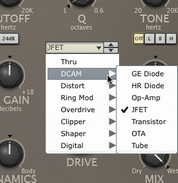Each of Maul's 3 drive stages features a very similar set of controls.

Filtering functions: Cutoff, Q, 24dB (all stages), Width (Mid stage only)
The filtering functions are available only in Multi (parallel) mode, and are used to determine the frequency band affected by each drive stage. Unlike the Tone function described below, these filtering functions are applied prior to the drive circuit in each drive stage.
If the Cutoff parameter is swept via modulation functions, a MIDI CC or host automation, the drive stage effectively acts as a swept resonant filter with an overdrive section after it in the signal path.
Each filter features a 12 dB per octave slope by default. This can be switched to a 24 dB per octave response by activating the 24dB button.
Low stage: Lowpass
In the Low drive stage, the Cutoff control adjusts the cutoff frequency of a lowpass filter. The Q control adjusts the amount of emphasis around the cutoff frequency.
Mid stage: Bandpass filter
In the Mid drive stage, the Cutoff control adjusts the centre frequency of a bandpass filter. The Q control adjusts the amount of emphasis around the centre frequency, while the Width control adjusts the bandwidth of the filter.
High stage: Highpass
In the High drive stage, the Cutoff control adjusts the cutoff frequency of a highpass filter. The Q control adjusts the amount of emphasis around the cutoff frequency.
Drive Type This selector allows you to choose between the 32 available distortion algorithms, which are described in the next section. Switch the selector to the 'Thru' setting to leave the signal passing through the stage unaffected by the distortion circuit. The other functions in the drive stage such as the Dynamics, Saturate and Tone functions can still be applied. Drive The Drive control adjusts the amount of distortion applied by the drive stage. |
|
Saturate
Activating the Saturate button enables the drive stage's saturation function.
The saturation behaviour is dependent on the level of the input signal. Note that this function is not a peak clipper - the output signal can still exceed 0dB depending on peaks in the input signal and further gain introduced by the Drive and Dynamics functions.
Dynamics
The Dynamics control offers a simple but powerful transient-shaping control which is applied before the distortion circuit. Towards the 'Bite' setting, attack transients are emphasized while sustain portions of the transient are de-emphasized. Towards the 'Body' setting, the opposite occurs: attacks in transients are de-emphasized while the sustain portion is emphasized. At the centre setting of 50%, there is no direct adjustment of incoming transients using this function (although transients can still be affected by the drive and saturation algorithms).
Tone This is a switchable Lowpass/Bandpass/Highpass filter with a cutoff frequency adjustable between 20Hz and 20kHz using the Tone control. The Tone filter is applied to the output of the drive stage, after the Drive amount has been applied. Switch between Lowpass, Bandpass and Highpass modes using the L, B and H buttons underneath the Tone control. To disable the Tone filter entirely, click the Off button. |
|
In Gain
The In Gain control adjusts the level of the signal entering the drive stage. The level can be adjusted between -inf dB and +18dB.
Out Gain
The Out Gain control adjusts the level of the signal leaving the drive stage. The level can be adjusted between -inf dB and +18dB.
Mix
The Mix control adjusts the balance between the incoming signal (Dry) and processed output (Wet) of the drive stage.
Mute, Solo
Each drive stage features a Mute and Solo button for removing it from or isolating it within the processed output.

